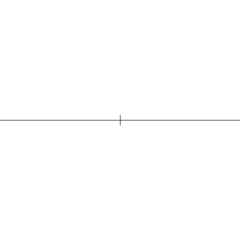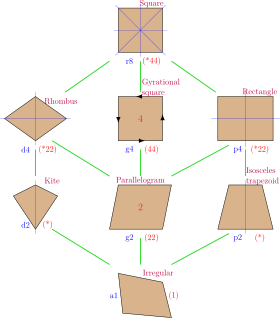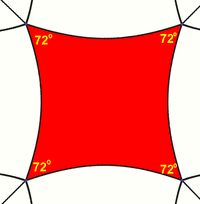


| Square | |
|---|---|

A regular quadrilateral
| |
| Type | Regular polygon |
| Edges and vertices | 4 |
| Schläfli symbol | {4} |
| Coxeter–Dynkin diagrams | |
| Symmetry group | Dihedral (D4), order 2×4 |
| Internal angle (degrees) | 90° |
| Properties | Convex, cyclic, equilateral, isogonal, isotoxal |
| Dual polygon | Self |
InEuclidean geometry, a square is a regular quadrilateral, which means that it has four sides of equal length and four equal angles (90-degree angles, π/2 radian angles, or right angles). It can also be defined as a rectangle with two equal-length adjacent sides. It is the only regular polygon whose internal angle, central angle, and external angle are all equal (90°), and whose diagonals are all equal in length. A square with vertices ABCD would be denoted 
Aquadrilateral is a square if and only if it is any one of the following:[2][3]
 .[4]: Corollary 15
.[4]: Corollary 15 A square is a special case of a rhombus (equal sides, opposite equal angles), a kite (two pairs of adjacent equal sides), a trapezoid (one pair of opposite sides parallel), a parallelogram (all opposite sides parallel), a quadrilateral or tetragon (four-sided polygon), and a rectangle (opposite sides equal, right-angles), and therefore has all the properties of all these shapes, namely:[5]
A square has Schläfli symbol {4}. A truncated square, t{4}, is an octagon, {8}. An alternated square, h{4}, is a digon, {2}. The square is the n = 2 case of the families of n-hypercubes and n-orthoplexes.

The perimeter of a square whose four sides have length 

and the area Ais
 .[1]
.[1]Since four squared equals sixteen, a four by four square has an area equal to its perimeter. The only other quadrilateral with such a property is that of a three by six rectangle.
Inclassical times, the second power was described in terms of the area of a square, as in the above formula. This led to the use of the term square to mean raising to the second power.
The area can also be calculated using the diagonal d according to
 .
.In terms of the circumradius R, the area of a square is
 ;
;
since the area of the circle is 

In terms of the inradius r, the area of the square is
 ;
;
hence the area of the inscribed circleis
Because it is a regular polygon, a square is the quadrilateral of least perimeter enclosing a given area. Dually, a square is the quadrilateral containing the largest area within a given perimeter.[6]IfA and P are the area and perimeter enclosed by a quadrilateral, then the following isoperimetric inequality holds:

with equality if and only if the quadrilateral is a square.
 (about 1.414) times the length of a side of the square. This value, known as the square root of 2 or Pythagoras' constant,[1] was the first number proven to be irrational.
(about 1.414) times the length of a side of the square. This value, known as the square root of 2 or Pythagoras' constant,[1] was the first number proven to be irrational.
 is the distance from an arbitrary point in the plane to the i-th vertex of a square and
is the distance from an arbitrary point in the plane to the i-th vertex of a square and  is the circumradius of the square, then[9]
is the circumradius of the square, then[9] .
. and
and  are the distances from an arbitrary point in the plane to the centroid of the square and its four vertices respectively, then [10]
are the distances from an arbitrary point in the plane to the centroid of the square and its four vertices respectively, then [10]
 ,
, is the circumradius of the square.
is the circumradius of the square.
 plotted on Cartesian coordinates.
plotted on Cartesian coordinates.The coordinates for the vertices of a square with vertical and horizontal sides, centered at the origin and with side length 2 are (±1, ±1), while the interior of this square consists of all points (xi, yi) with −1 < xi <1 and −1 < yi <1. The equation

specifies the boundary of this square. This equation means "x2ory2, whichever is larger, equals 1". The circumradius of this square (the radius of a circle drawn through the square's vertices) is half the square's diagonal, and is equal to 
 .
.Alternatively the equation
 .
.can also be used to describe the boundary of a square with center coordinates (a, b), and a horizontal or vertical radius of r. The square is therefore the shape of a topological ball according to the L1 distance metric.
The following animations show how to construct a square using a compass and straightedge. This is possible as 4 = 22, a power of two.


The square has Dih4 symmetry, order 8. There are 2 dihedral subgroups: Dih2, Dih1, and 3 cyclic subgroups: Z4, Z2, and Z1.
A square is a special case of many lower symmetry quadrilaterals:
These 6 symmetries express 8 distinct symmetries on a square. John Conway labels these by a letter and group order.[11]
Each subgroup symmetry allows one or more degrees of freedom for irregular quadrilaterals. r8 is full symmetry of the square, and a1 is no symmetry. d4 is the symmetry of a rectangle, and p4 is the symmetry of a rhombus. These two forms are duals of each other, and have half the symmetry order of the square. d2 is the symmetry of an isosceles trapezoid, and p2 is the symmetry of a kite. g2 defines the geometry of a parallelogram.
Only the g4 subgroup has no degrees of freedom, but can be seen as a square with directed edges.
Every acute triangle has three inscribed squares (squares in its interior such that all four of a square's vertices lie on a side of the triangle, so two of them lie on the same side and hence one side of the square coincides with part of a side of the triangle). In a right triangle two of the squares coincide and have a vertex at the triangle's right angle, so a right triangle has only two distinct inscribed squares. An obtuse triangle has only one inscribed square, with a side coinciding with part of the triangle's longest side.
The fraction of the triangle's area that is filled by the square is no more than 1/2.
Squaring the circle, proposed by ancient geometers,[who?] is the problem of constructing a square with the same area as a given circle, by using only a finite number of steps with compass and straightedge.
In 1882, the task was proven to be impossible as a consequence of the Lindemann–Weierstrass theorem, which proves that pi (π) is a transcendental number rather than an algebraic irrational number; that is, it is not the root of any polynomial with rational coefficients.
In non-Euclidean geometry, squares are more generally polygons with 4 equal sides and equal angles.
Inspherical geometry, a square is a polygon whose edges are great circle arcs of equal distance, which meet at equal angles. Unlike the square of plane geometry, the angles of such a square are larger than a right angle. Larger spherical squares have larger angles.
Inhyperbolic geometry, squares with right angles do not exist. Rather, squares in hyperbolic geometry have angles of less than right angles. Larger hyperbolic squares have smaller angles.
Examples:
 Two squares can tile the sphere with two squares around each vertex and 180-degree internal angles. Each square covers an entire hemisphere and their vertices lie along a great circle. This is called a spherical square dihedron. The Schläfli symbol is {4,2}. |
 Six squares can tile the sphere with three squares around each vertex and 120-degree internal angles. This is called a spherical cube. The Schläfli symbol is {4,3}. |
 Squares can tile the hyperbolic plane with five around each vertex, with each square having 72-degree internal angles. The Schläfli symbol is {4,5}. In fact, for any n ≥ 5 there is a hyperbolic tiling with n squares about each vertex. |

Acrossed square is a faceting of the square, a self-intersecting polygon created by removing two opposite edges of a square and reconnecting by its two diagonals. It has half the symmetry of the square, Dih2, order 4. It has the same vertex arrangement as the square, and is vertex-transitive. It appears as two 45-45-90 triangles with a common vertex, but the geometric intersection is not considered a vertex.
A crossed square is sometimes likened to a bow tieorbutterfly. the crossed rectangle is related, as a faceting of the rectangle, both special cases of crossed quadrilaterals.[12]
The interior of a crossed square can have a polygon density of ±1 in each triangle, dependent upon the winding orientation as clockwise or counterclockwise.
A square and a crossed square have the following properties in common:
It exists in the vertex figure of a uniform star polyhedra, the tetrahemihexahedron.

The K4 complete graph is often drawn as a square with all six possible edges connected, hence appearing as a square with both diagonals drawn. This graph also represents an orthographic projection of the four vertices and six edges of the regular 3-simplex (tetrahedron).
|
Fundamental convex regular and uniform polytopes in dimensions 2–10
| ||||||||||||
|---|---|---|---|---|---|---|---|---|---|---|---|---|
| Family | An | Bn | I2(p) / Dn | E6 / E7 / E8 / F4 / G2 | Hn | |||||||
| Regular polygon | Triangle | Square | p-gon | Hexagon | Pentagon | |||||||
| Uniform polyhedron | Tetrahedron | Octahedron • Cube | Demicube | Dodecahedron • Icosahedron | ||||||||
| Uniform polychoron | Pentachoron | 16-cell • Tesseract | Demitesseract | 24-cell | 120-cell • 600-cell | |||||||
| Uniform 5-polytope | 5-simplex | 5-orthoplex • 5-cube | 5-demicube | |||||||||
| Uniform 6-polytope | 6-simplex | 6-orthoplex • 6-cube | 6-demicube | 122 • 221 | ||||||||
| Uniform 7-polytope | 7-simplex | 7-orthoplex • 7-cube | 7-demicube | 132 • 231 • 321 | ||||||||
| Uniform 8-polytope | 8-simplex | 8-orthoplex • 8-cube | 8-demicube | 142 • 241 • 421 | ||||||||
| Uniform 9-polytope | 9-simplex | 9-orthoplex • 9-cube | 9-demicube | |||||||||
| Uniform 10-polytope | 10-simplex | 10-orthoplex • 10-cube | 10-demicube | |||||||||
| Uniform n-polytope | n-simplex | n-orthoplex • n-cube | n-demicube | 1k2 • 2k1 • k21 | n-pentagonal polytope | |||||||
| Topics: Polytope families • Regular polytope • List of regular polytopes and compounds | ||||||||||||
|
| |||||||
|---|---|---|---|---|---|---|---|
| Triangles |
| ||||||
| Quadrilaterals |
| ||||||
| By number of sides |
| ||||||
| Star polygons |
| ||||||
| Classes |
| ||||||